Wondering how can you incorporate the Japndi style into your bathroom design?
Here’s how I do it:
If you don’t know already, Japandi is a design trend that combines the minimalist elegance of Japanese design with the functionality and coziness of Scandinavian (Scandi) style.
So, to create a Japandi bathroom, I usually focus on these fundamental elements:
- Natural materials (use wood, bamboo, rattan and stone etc. for a natural and organic feel).
- Neutral color palettes (try to stick to earthy, muted colors like beige, gray, and white).
- Clean lines (choose simple, geometric shapes for fixtures and furniture).
- Minimalism (keep things simple – less is more with minimalist-inspired design).
- Functionality (make sure the furniture you do have is practical and space-saving, because you won’t have much of it!)
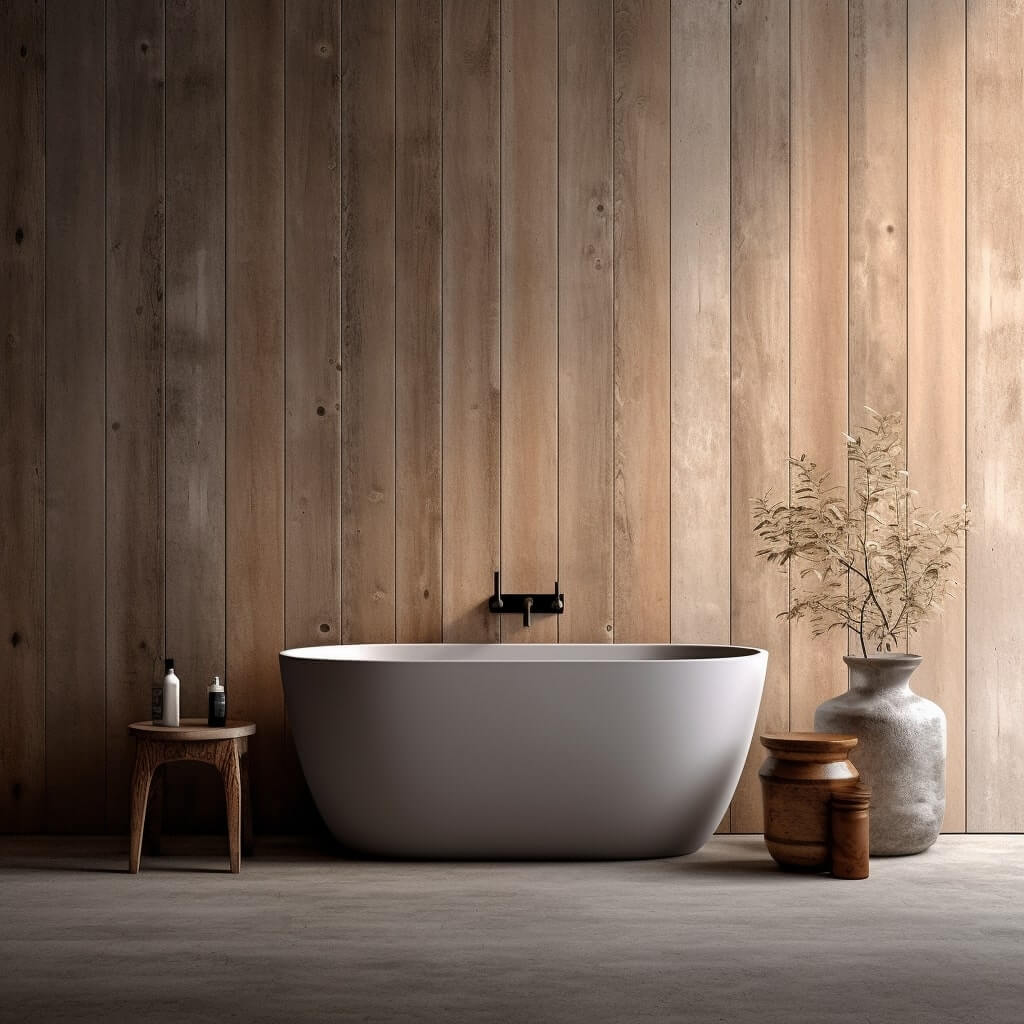
Japandi bathroom ideas
Here are a few of my favourite ideas specific to creating a Japandi-inspired bathroom:
Freestanding bathtub
If you have the space for it, look for a simple, naturally-shaped tub with clean lines. A nice scandi-inspired bath mat can add warmth too.
Wooden accents
See if you can incorporate simple and elegant wooden shelves or a vanity for your storage. Keep items and accessories stored away where possible (but practically placed and easy to get to, to encourage Zen-like living).
Zen greenery
I love using potted plants or hanging greenery create a wonderfully calming atmosphere. Just make sure they’re getting sufficient light and they’re not overcrowding your space.
Minimalist lighting
It’s tempting to rely on the overhead light fixtures in your bathroom, but selecting more understated Japandi lighting fixtures like pendant lights or recessed lighting is much better for the Japandi look – just make sure it’s bright enough for your grooming activity.
Functional storage
I use streamlined storage solutions like floating shelves or wall-mounted cabinets to save on floor space. Make sure your essentials are easy-to-access. Particularly important for smaller bathrooms like en-suites and apartment bathrooms.
For me, Japandi is about peaceful and practical living – you don’t want to be rummaging through drawers that are awkward to access just to get your toothbrush.
Personal touches
I think it’s important to personalize your Japandi bathroom with unique touches:
- Showcase some minimalist, nature-inspired Japandi wall art.
- Get some organic cotton or linen towels and bath mats in neutral colors.
- Use essential oils or candles with subtle, natural scents like sandalwood or lavender.
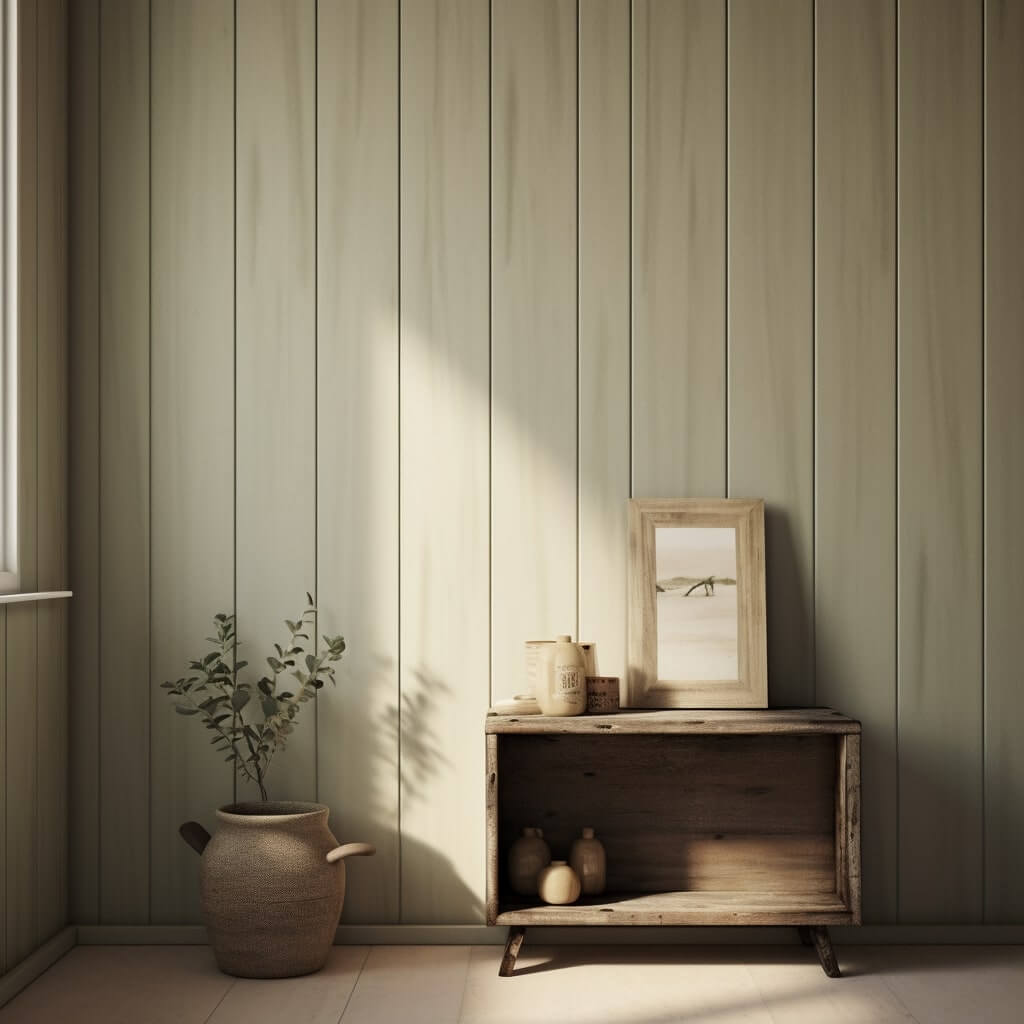
Japandi Bathroom Layout Ideas
I find that the Japandi philosophy is about creating a space you’re comfortable in.
While minimalism and aesthetics are a part of that, having a practical and easy-to-use layout is equally important.
You want everything you need in a convenient, accessible place, while ensuring your space isn’t cluttered and crowded.
Here are some layout ideas for your Japandi bathroom:
Aim to:
- Make the most of natural light
Utilize that bathroom window light by putting your mirror in the sunspots. It will help create a more airy atmosphere. Also, using lighter shades on walls and tiles will reflect and amplify natural light.
- Minimize clutter
My mantra is keeping countertops and surfaces clear of unnecessary items where possible. If you have kids this might be almost impossible – but a few minimalist, practical storage solutions can go a long way!
- Use floating elements
Can you install floating vanities and shelves? They save on floor space which creates the feeling of an open plain.
- Make the most of glass
Glass shower enclosures can make your space feel bigger – but also, walk in showers or wetrooms can create the illusion of a much bigger space too (if you have the space for it in the first place).
- Incorporating greenery
Greenery adds life to your bathroom.
- Try using potted plants – small plants that fit nicely on shelves or countertops.
- Use some hanging planters – suspend them from the ceiling or hooks.
- Adding a living wall – if you have the space and time to maintain it, a vertical garden in your bathroom is a bold statement.
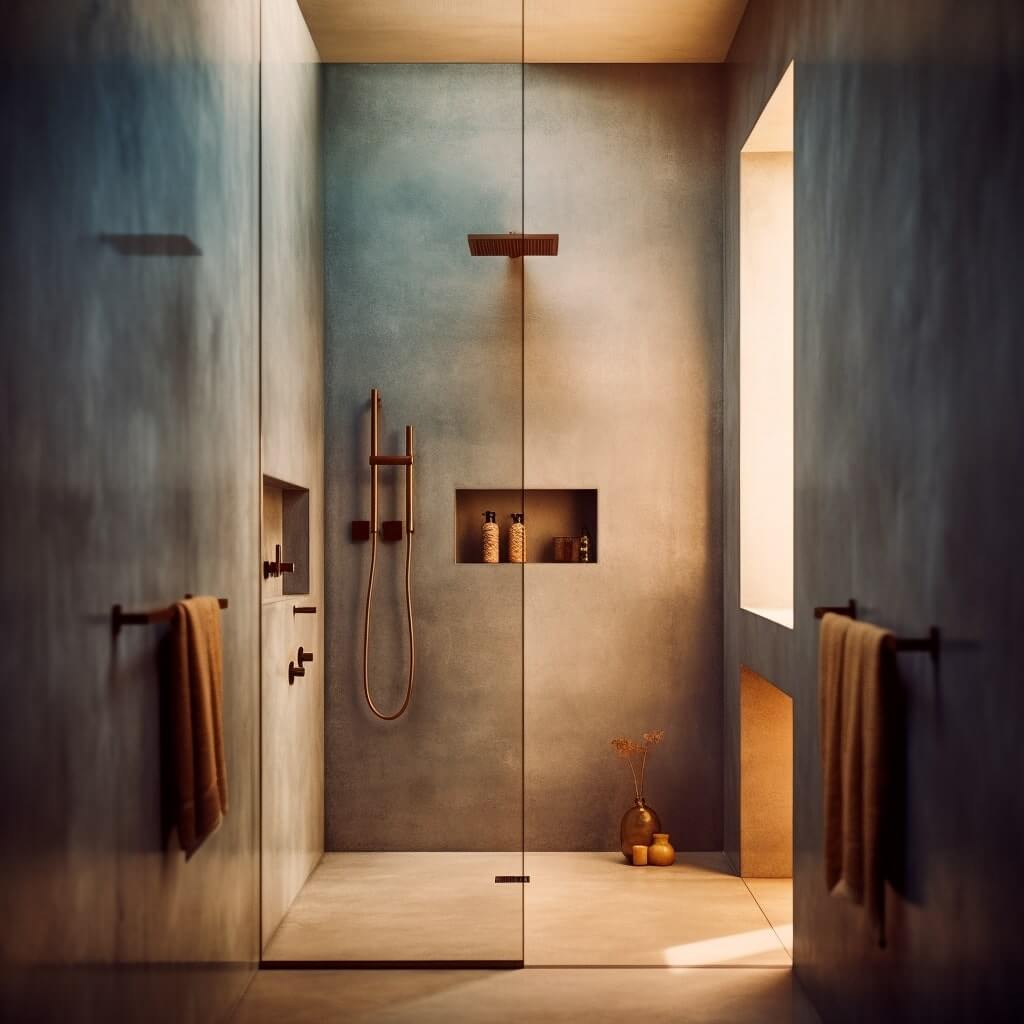
Japandi Bathroom Fixtures and Furniture
Here are some ideas for Japandi furniture and fixtures to consider in your bathroom:
A Japanese soaking tub or Ofuro
A Japanese soaking tub, or Ofuro, is a perfect addition to a Japandi bathroom.
They’re generally very space-efficient, focusing on depth as opposed to length which is a nice touch. And they’re such an indulgent relaxation piece.
Keep in mind:
Shape and material – Go for a deep, square or round tub that’s simplistic in its design.
Placement – Position the tub near a window if possible to enjoy the view and natural light.
Pair with a shower – Combining your Ofuro with a minimalist, walk-in shower is a match made in heaven.
A minimalist vanity
When shopping for a Japandi-style vanity:
- Choose clean lines and a simple design without ornate details.
- Use natural materials, so a wooden vanity in a light or medium finish, for example.
- Ensure plenty of storage space with drawers or cabinets.
Other bathroom furniture ideas
I love installing floating wooden shelves to elegantly display plants, towels, and toiletries.
You can also include a small wooden stool or Japandi bench for a touch of minimalist functionality.
I also gravitate towards minimalist towel racks made of wood or metal in a simple design.
Go with a simple, frameless mirror, or one with a slim wooden frame to keep things uncomplicated.
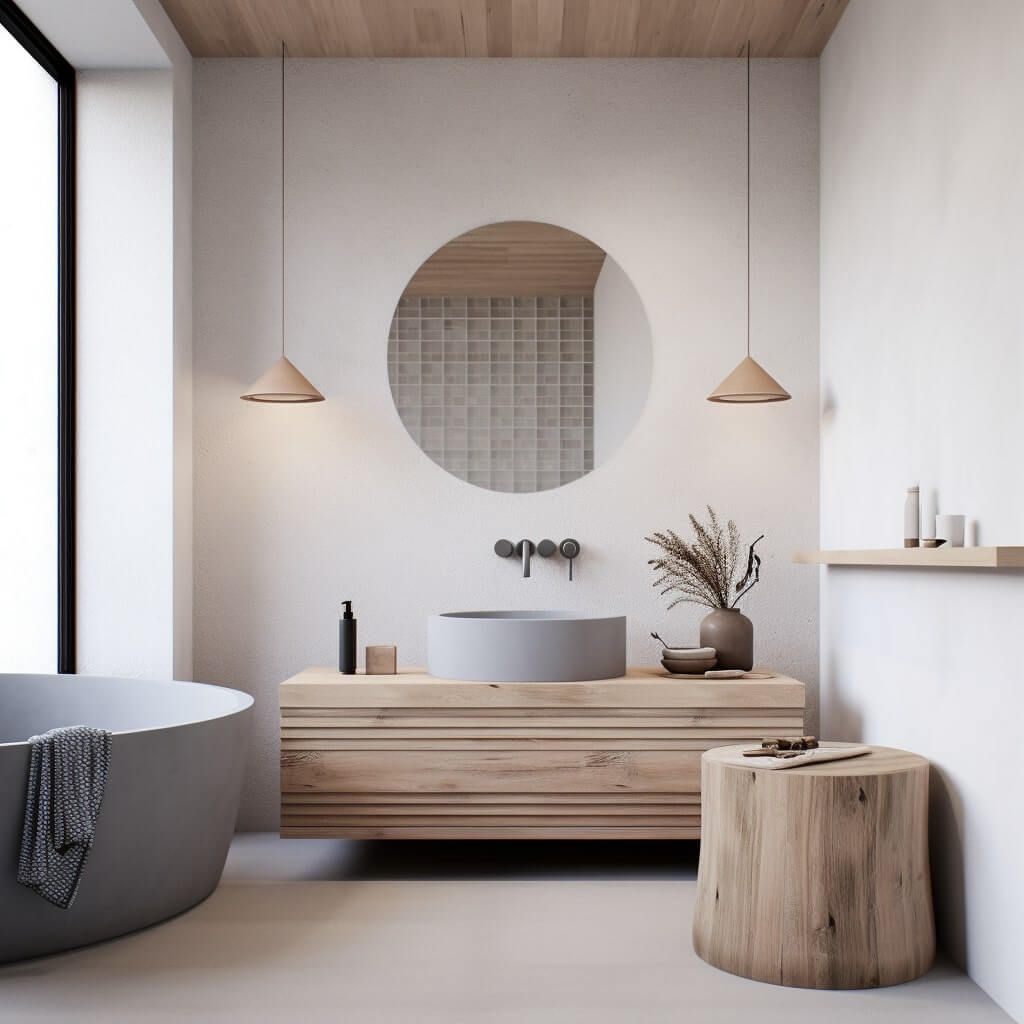
Japandi Bathroom Décor and Accessories
To complete your bathroom transformation, Japandi décor and accessories are the final touch to complement your design philosophy.
Here are some ideas I often refer to:
Simple but sophisticated Japandi art can enhance the ambience of your bathroom.
- Choose minimalist, nature-themed pieces.
- Focus on simple wooden frames or frameless art.
- In terms of placement, hang artwork on a focal wall or above the vanity, for example.
Incorporating Japanese and Scandinavian textiles
Japandi textiles contribute to the overall comfort and warmth of your bathroom.
I like to keep these tips in mind:
- Select organic cotton or linen towels and bath mats in neutral colors.
- Choose a simple, understated shower curtain if you’re using one, with a light, natural hue.
- For your bathroom robes, look for plush, neutral-colored robes for added luxury and comfort.
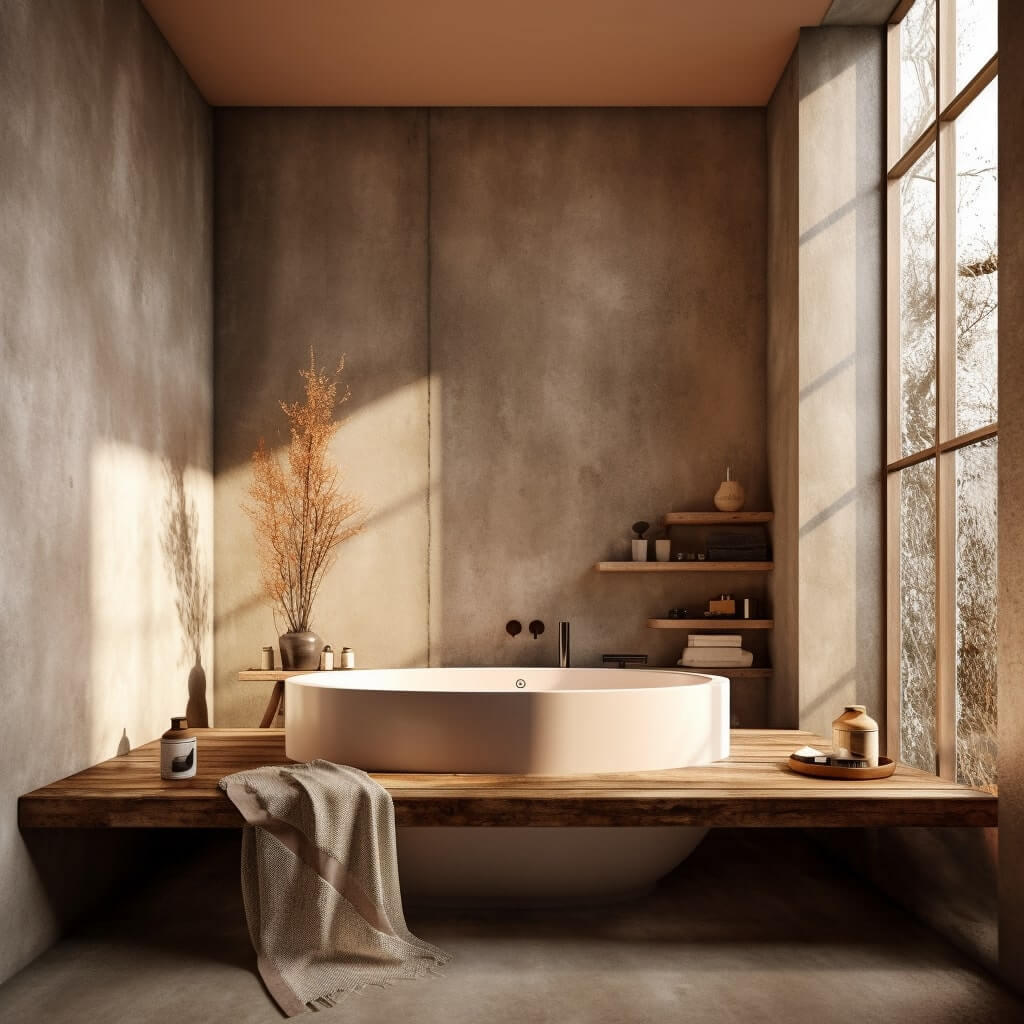
Using minimalist lighting fixtures
Lighting sets the mood in your Japandi bathroom. Try to use one of these 3 options that are a bit more subtle and controllable:
- Pendant lights
- Recessed lighting
- Dimmers
Subtle touches of Zen
Here are my favourite Zen-inspired accessories to contribute to your Japandi style in the bathroom:
- Candles and diffusers
I love subtle, natural scents like sandalwood or lavender to create a calming environment.
- Stone elements
Add a small collection of smooth stones or a stone soap dish for an earthy touch.
- Bamboo tray
Try getting a bamboo tray for over the tub for added functionality and style.
Your ultimate goal is to create a bathroom that offers a calming retreat from daily life.
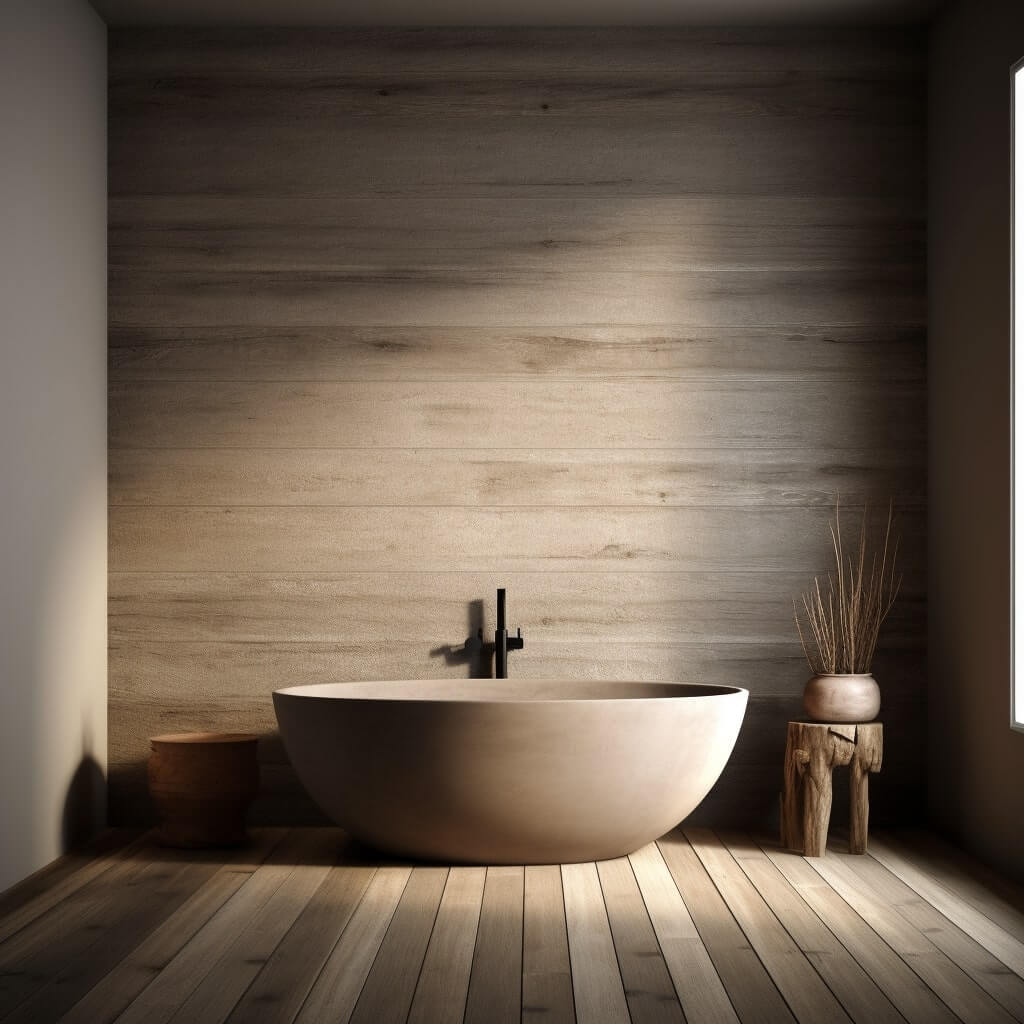
Japandi Bathroom Colors
I find the color scheme plays a crucial role in capturing the essence of a Japandi bathroom.
Here’s how to create the perfect Japandi colour palette for the bathroom:
- Start with your base colours
Begin with a neutral color palette, including shades of beige, gray, and white.
- Add some natural, earthy accents:
When you’ve got your foundation colors laid out, compliment them with subtle earthy tones, such as soft greens, muted blues, or warm browns, or even dusty pinks.
Try to stick to colors that you typically see in nature (the possibilities are endless really!).
- Balance light and dark contrasts
To create visual interest and harmony in your bathroom try to balance the light and dark elements:
- Choose lighter colors for walls, tiles, and large furniture pieces.
- Add contrast with darker accessories, such as towel racks, faucets, or picture frames.
- Avoid harsh color contrasts by using shades that gradually transition from light to dark.
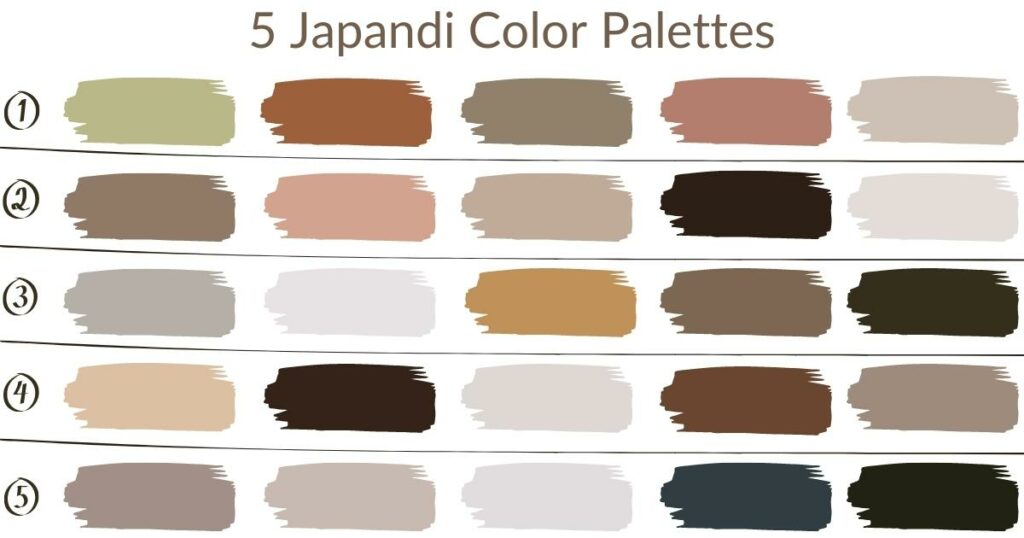
Scandinavian warmth with wooden elements
Wooden elements are key to adding warmth and texture to your Japandi bathroom and bring out the Scandi, sauna-like vibe.
I like to use light to medium wood tones, such as oak, ash, or maple, for a Scandinavian influence.
And in terms of furniture, think wooden vanities, shelves, or seating.
You can even add wooden accessories like a bath mat, mirror frame, or towel hooks for more subtle additions.
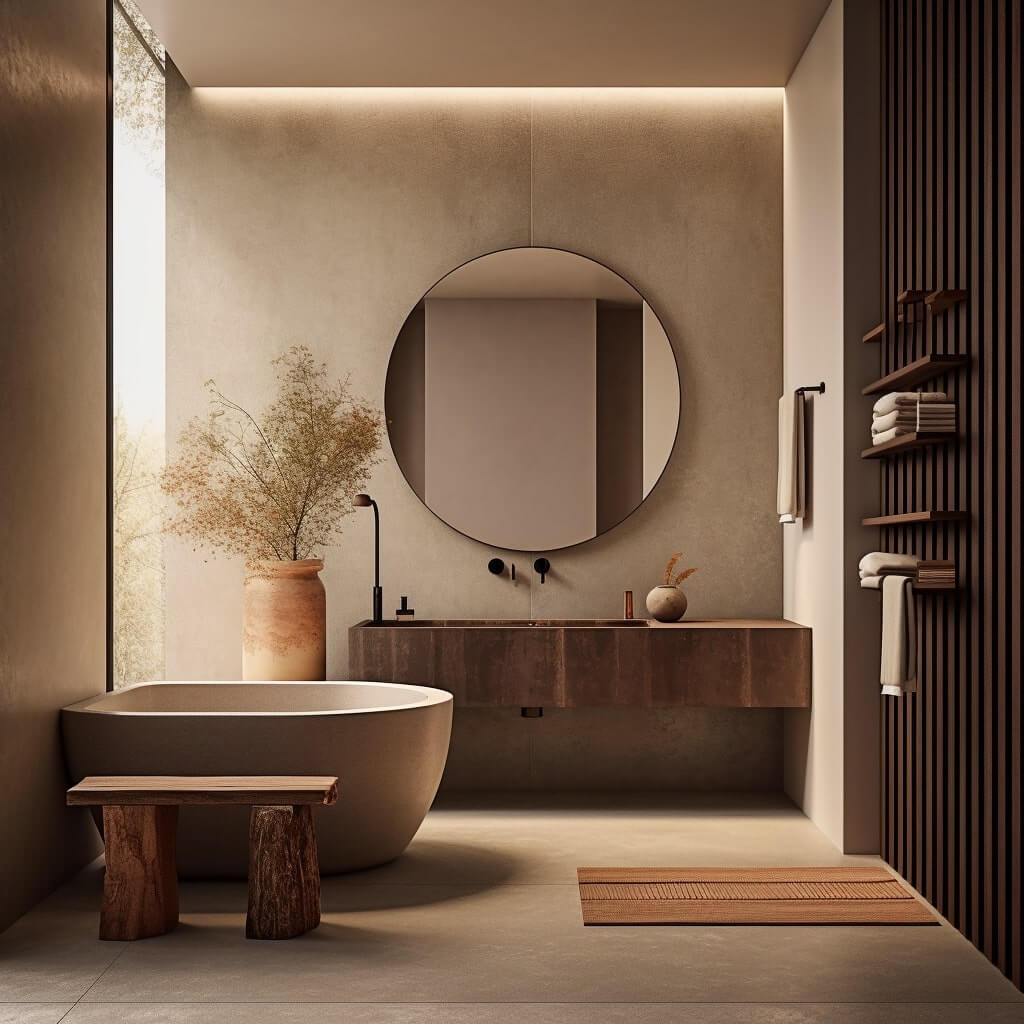
Japandi Bathroom Flooring and Wall Options
To create a truly authentic Japandi bathroom, I gravitate towards these flooring and wall options:
Japandi style calls for natural materials underfoot:
- Wood (light to medium-toned wooden floors, such as oak or bamboo)
- Stone (choose natural stone tiles, like slate or limestone)
- Porcelain (go for some porcelain tiles that mimic the appearance of wood or stone for a durable, low-maintenance alternative)
As for your walls, I often use these Japandi-inspired finishes:
- A natural, textured plaster finish in a neutral color for a warm, organic feel.
- Install shiplap or vertical wooden panels in light-toned wood for a Scandinavian touch.
- Create a feature wall with textured tiles, such as a stone mosaic or a patterned ceramic design.
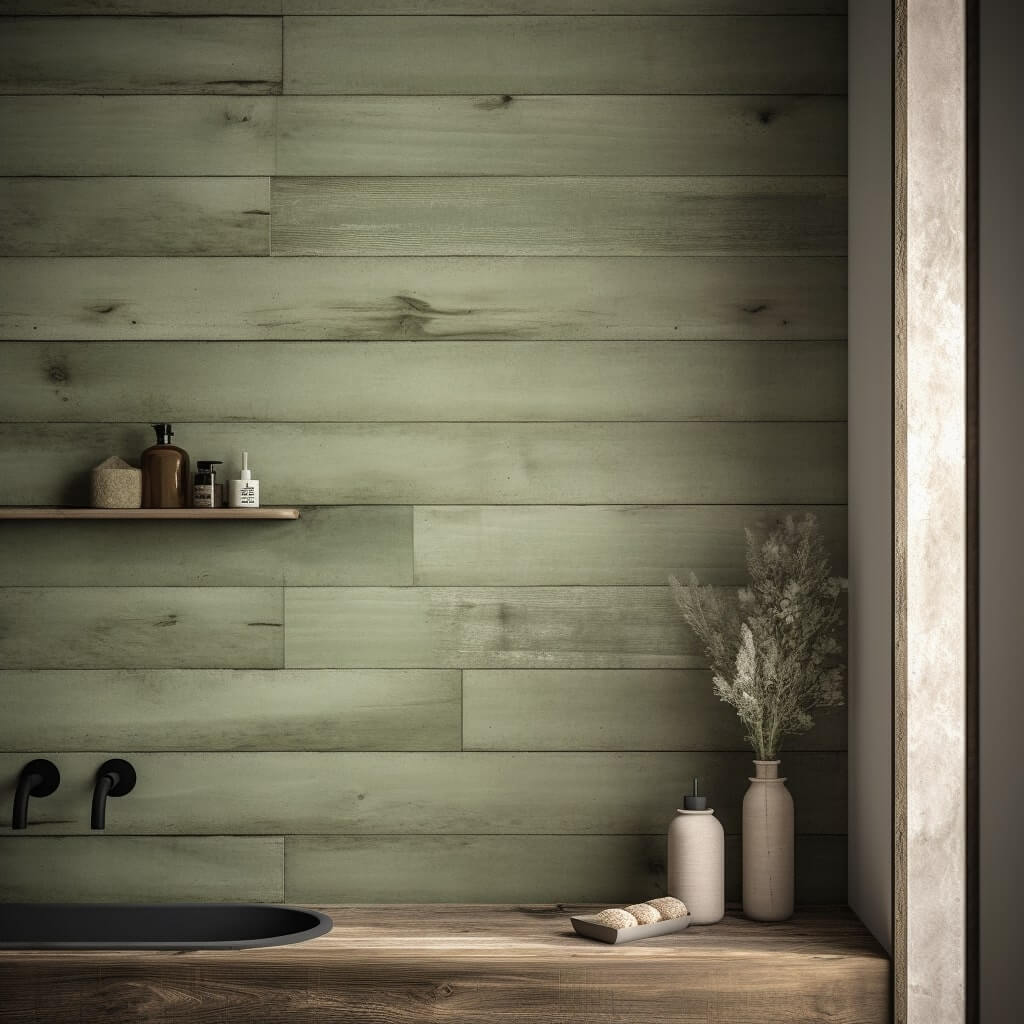
Japandi bathroom tile designs
When choosing tiles for a Japandi bathroom, here are some of my go-tos:
- Go with subtle geometric or nature-inspired patterns that are understated and elegant.
- Use soft, earthy tones that complement the overall color scheme.
- Try to combine different tile styles and materials where possible and get creative.
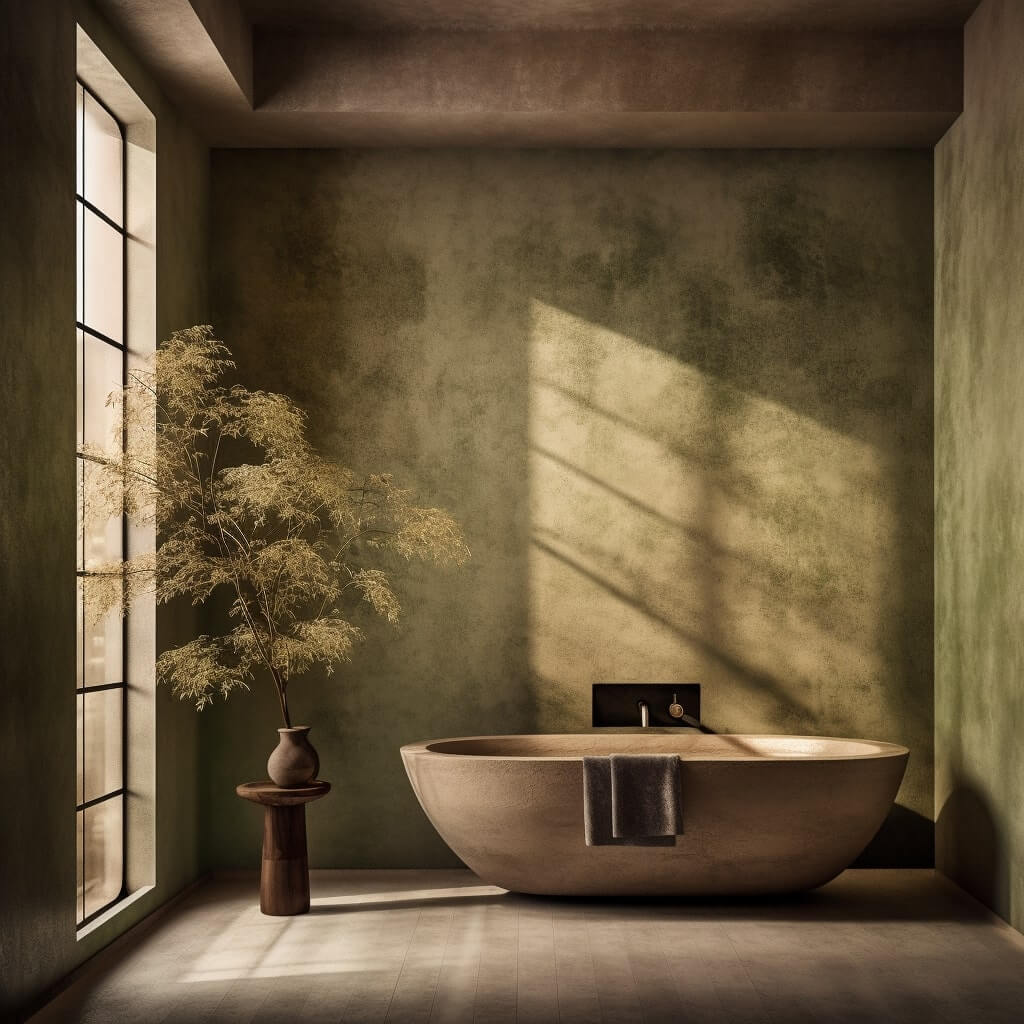
Maintaining a Japandi Bathroom
Here are my tips for keeping your Japandi bathroom clean, sustainable, and fresh (it’s great for wellness at home):
- Stick to a regular cleaning routine
- Utilize minimalist storage options like drawers, cabinets, and shelves to keep items organized and out of sight.
- Declutter your bathroom from time to time to ensure it remains a tranquil space.
Sustainability is a cornerstone of the Japandi philosophy too. Think about potential eco-friendly practices such as:
- Installing low-flow faucets and showerheads to conserve water.
- Choosing organic, eco-friendly bath products and cleaning supplies.
- Opting for LED lighting and energy-efficient appliances to reduce energy consumption.
And finally, consider updating your bathroom with seasonal touches:
- Consider rotating towels, bath mats, and shower curtains for different colors or textures that reflect the current season.
- Rotate plants or add seasonal blooms to bring in new life and energy.
- Update small décor items, such as candles, diffusers, or art, to create a subtle seasonal shift.
What is a Japandi bathroom?
A Japandi bathroom combines Japanese minimalism and Scandinavian functionality, featuring clean lines, natural elements, a calming color palette, and a balance of simplicity and comfort.
How to design a Japanese style bathroom?
Incorporate natural materials, soak tubs, minimalistic decor, and neutral colors. Privacy and tranquility are key.
What are the elements of a Japanese bathroom?
Deep soaking tubs, natural materials like wood and stone, minimalistic design, and separate areas for cleaning and relaxing.
Are Japandi bathrooms waterproof?
Yes, Japandi bathrooms are typically waterproof. Wet and dry areas are separated for easy cleaning and prevention of mold.
What is a typical Japandi toilet?
A typical Japanese toilet can feature advanced technologies such as heated seats, bidet functions, and often, a control panel for customizable comfort. Or it can be a more simplistic, minimalist design that’s comfortable but practical.
How to make a Zen bathroom?
A Zen bathroom can be created with natural colors, minimal decor, natural light, and elements that promote relaxation like plants or a soaking tub.
What is the most relaxing color for a bathroom?
Blue is considered the most relaxing color for a bathroom. It brings in feelings of tranquility and peace, similar to a serene body of water.
How do you make a small bathroom feel luxurious?
Use light colors, glass fixtures, good lighting, and high-quality materials. Keep clutter minimal and add a few elegant accents.
Japandi bathroom tiles?
Japandi bathroom tiles are often neutral, featuring natural tones. Texture is important too, with matte finishes, stone-like surfaces, or wood-grain effects popular.
Japandi Small bathroom design?
For a Japandi small bathroom design, maximize space with clever storage, maintain a neutral color palette, and incorporate natural elements for a clean, open feel.
Japandi vanity unit?
A Japandi vanity unit typically features clean lines, minimal detailing, and combines both natural wood tones with white or other neutral colors.

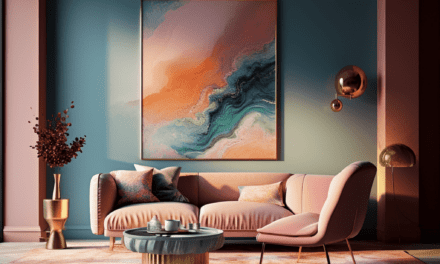
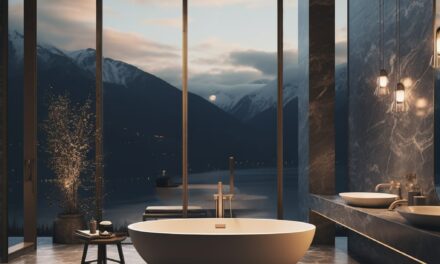

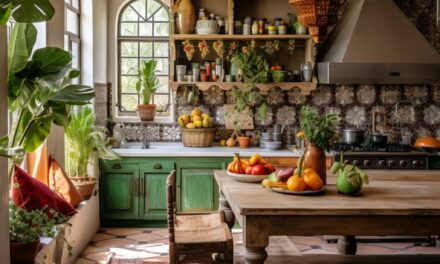
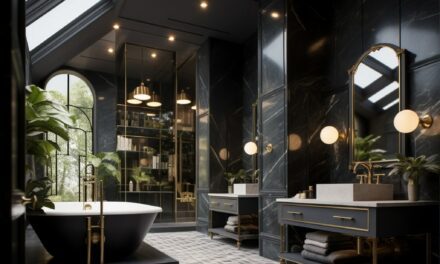
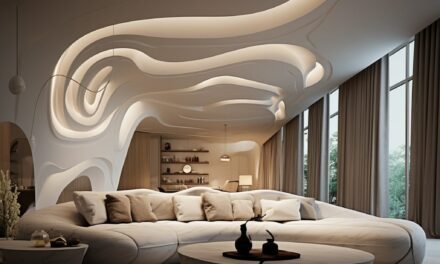
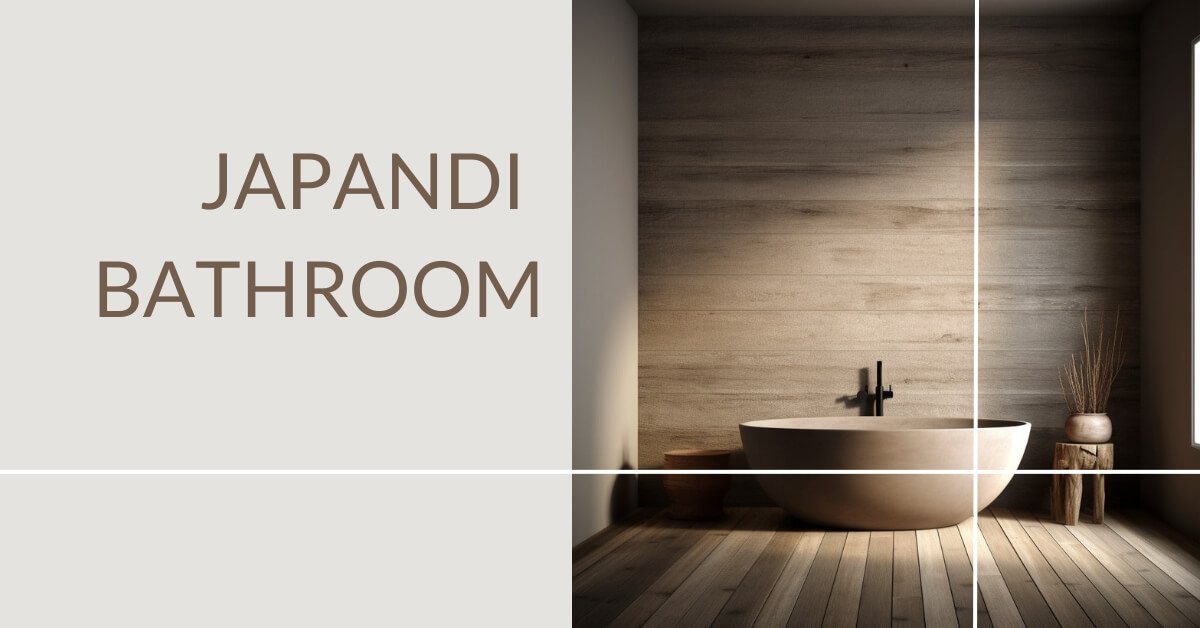
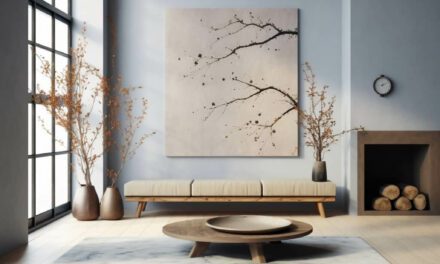
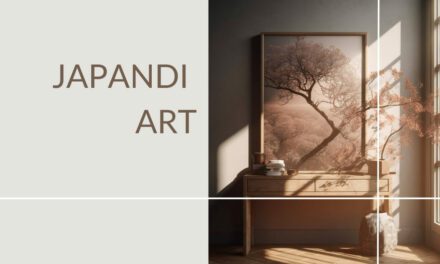

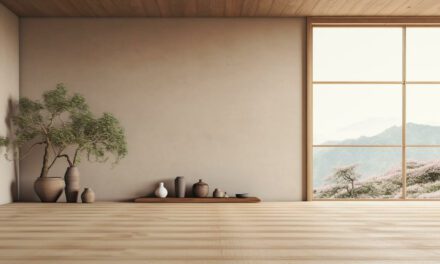
Thanks a lot for sharing this with all of us you actually know what you’re talking about! Bookmarked. Please also visit my web site =). We could have a link exchange arrangement between us!
Wonderful goods from you, man. I’ve understand your stuff previous to and you are just too fantastic. I actually like what you’ve acquired here, really like what you are saying and the way in which you say it. You make it entertaining and you still care for to keep it wise. I cant wait to read much more from you. This is actually a wonderful website.
Great blog! Is your theme custom made or did you download it from somewhere? A theme like yours with a few simple tweeks would really make my blog jump out. Please let me know where you got your design. Thank you
Hi, we use the Divi theme 🙂
Hello there! Quick question that’s entirely off topic. Do you know how to make your site mobile friendly? My web site looks weird when viewing from my apple iphone. I’m trying to find a theme or plugin that might be able to resolve this issue. If you have any suggestions, please share. With thanks!
Hi, we use the Divi theme 🙂
Hey there! This post couldn’t be written any better!
Reading through this post reminds me of my previous room mate!
He always kept chatting about this. I will forward this write-up
to him. Fairly certain he will have a good read.
Many thanks for sharing!